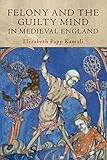Felony and the guilty mind in medieval England / By Elizabeth Papp Kamali
Series: Studies in Legal HistoryPublication details: London Cambridge University Press 2020Description: xv, 336 pages 24 cmISBN:- 9781108712743 (Paperback)
- 345.420902
| Item type | Current library | Shelving location | Call number | Materials specified | Status | Notes | Barcode | |
|---|---|---|---|---|---|---|---|---|
 BOOKs
BOOKs
|
National Law School | New Arrival - Display Area | 345.420902 KAM (Browse shelf(Opens below)) | PB | Not For Loan | Recommended by Mr. Kunal Ambasta | 40411 |
Browsing National Law School shelves,Shelving location: New Arrival - Display Area Close shelf browser (Hides shelf browser)
List of figures -
Acknowledgments -
List of abbreviations -
Introduction -
The history of Mens Rea -
Methodology -
The trial jury and its predecessors: Anglo-Saxon and Angevin Antecedents -
A brief chapter summary -
The essentials of medieval English felony procedure -
Part I. Felonia Felonice Facta: Felony and Intentionality:
2. Felony in the archives -
Part II. Þe Deuylys Doghtyr of Hellë Fyre: Felony and Emotion:
3. The language of anger -
4. Cultural understandings of anger -
Part III. Handlyng Synne: Guilt and Innocence:
5. Confession and circumstantial inquiry -
6. Guilt assessment in medieval England -
Part IV. Dies Iræ: Judge and Jury:
7. Tales of judging -
8. The mind and comportment of judge and jury -
Conclusion -
Looking back -
Looking forward -
Legal literacy and the medieval English jury -
Bibliography -
Index.
This book explores the role of mens rea, broadly defined as a factor in jury assessments of guilt and innocence from the early thirteenth through the fourteenth century - the first two centuries of the English criminal trial jury. Drawing upon evidence from the plea rolls, but also relying heavily upon non-legal textual sources such as popular literature and guides for confessors, Elizabeth Papp Kamali argues that issues of mind were central to jurors' determinations of whether a particular defendant should be convicted, pardoned, or acquitted outright. Demonstrating that the word 'felony' itself connoted a guilty state of mind, she explores the interplay between social conceptions of guilt and innocence and jury behavior. Furthermore, she reveals a medieval understanding of felony that involved, in its paradigmatic form, three essential elements: an act that was reasoned, was willed in a way not constrained by necessity, and was evil or wicked in its essence.
Examines what factors juries weighed in sorting the guilty from the innocent in the first two centuries of the criminal trial jury
Situates the medieval English law of felony in a broader cultural, social, and religious setting
Speaks to current controversies in the field of criminal law, such as the role of intentionality in determining the bounds of criminal responsibility
There are no comments on this title.







